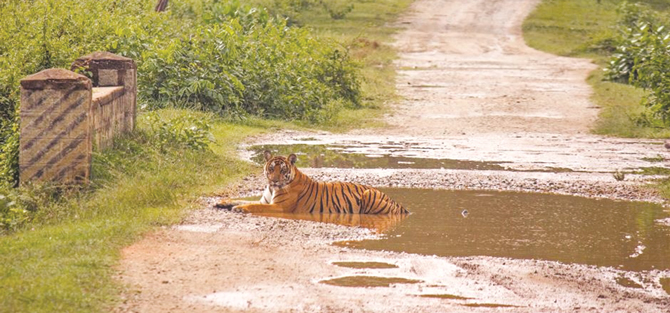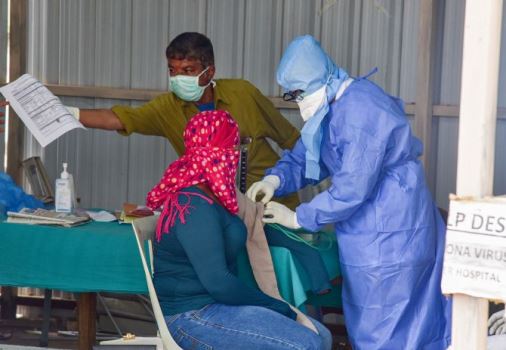99 species of reptiles, amphibians recorded in Chure range

By Indira Aryal
Kathmandu, June 12: At least 99 species of herpetofauna (reptiles and amphibians) were recorded from the entire Chure Range of Nepal. That accounts for 55 per cent of the total herpetofauna recorded in the country.
A study titled “Amphibians and Reptiles of Chure Range of Nepal” carried out by President Chure Terai-Madesh Conservation Development Board and National Trust for Conservation Nepal (NTNC) revealed that among the 99 species of herpetofauna, 24 species were amphibians belonging to six families and 75 species were reptiles belonging to 17 families.
Dr. Naresh Subedi, NTNC conservation programme manager, said that the study was carried out to identify the important amphibians and reptiles of the Chure range which is very important for the ecosystem.
“People only talk about big wild animals, but amphibians and reptiles are also equally important for the environment. These creatures might be at risk of disappearing for good without their proper documentation. So, this study will help in decision-making level while carrying out development works in the Chure region,” said Dr. Subedi.
He added that the documentation of such creatures will help future generation to know about the existence of such creatures in the whole range.
The study was a part of Faunal Diversity Assessment in the Chure range of Nepal to explore faunal diversity in changing climatic and political scenarios. “Amphibians and reptiles are the most vulnerable group in the changing climatic context. Such species also help to track climate change status and they can serve as an indicator,” he said.
Research on amphibians and reptiles has not been given needed importance in Nepal. People talk only about the conservation of such species without proper study, he said.
According to Dr. Subedi, the Chure range is a biodiversity-rich landscape, providing habitat for diverse flora and fauna. Although various herpetofauna species are reported from this range, a comprehensive study on herpetofauna diversity is lacking.
According to Santosh Bhattarai, NTNC conservation officer, out of the total species found in Nepal, 55 per cent are in the Chure Range. During the study, two new species, namely water monitor lizard (Varanus Salvator) and Golden-backed frog (Hydrophyllax Leptoglossus) were recorded for the first time in Nepal, he said.
“There should be more research and exploration on the Chure range as there might be more than hitherto known species living there,” Bhattarai said.
The natural habitat of the Chure range is highly disturbed by fire, cattle grazing and human activities. That has negatively affected its biodiversity. Therefore, further studies on herpetofauna and conservation initiatives are important, the report said.
The study also reported rich biodiversity in the region and pointed at the importance of conservation programme.
Human pressure is relatively high in the area. The camera traps made in course of the study captured 58 images of people with guns in seven different areas, indicating widespread poaching of wildlife.
High grazing pressure especially in the western and far-western Chure region was documented. According the report, reducing human pressures through enhanced enforcement, community awareness for wildlife conservation and restoration of critical sites are necessary to keep the region intact.
Periodic monitoring of biodiversity is required to detect changes over time and enhance our knowledge about the biodiversity, the report said.
For the study survey, the entire Chure Range was divided into four blocks -- Mechi River to Bagmati river section for the eastern block, Bagmati River to Tinau river section for the central block, Tinau River to Karnali river section for the western block, and Karnali River to Mahakali river section for the far western block.
Recent News

Do not make expressions casting dout on election: EC
14 Apr, 2022
CM Bhatta says may New Year 2079 BS inspire positive thinking
14 Apr, 2022
Three new cases, 44 recoveries in 24 hours
14 Apr, 2022
689 climbers of 84 teams so far acquire permits for climbing various peaks this spring season
14 Apr, 2022
How the rising cost of living crisis is impacting Nepal
14 Apr, 2022
US military confirms an interstellar meteor collided with Earth
14 Apr, 2022
Valneva Covid vaccine approved for use in UK
14 Apr, 2022
Chair Prachanda highlights need of unity among Maoist, Communist forces
14 Apr, 2022
Ranbir Kapoor and Alia Bhatt: Bollywood toasts star couple on wedding
14 Apr, 2022
President Bhandari confers decorations (Photo Feature)
14 Apr, 2022









